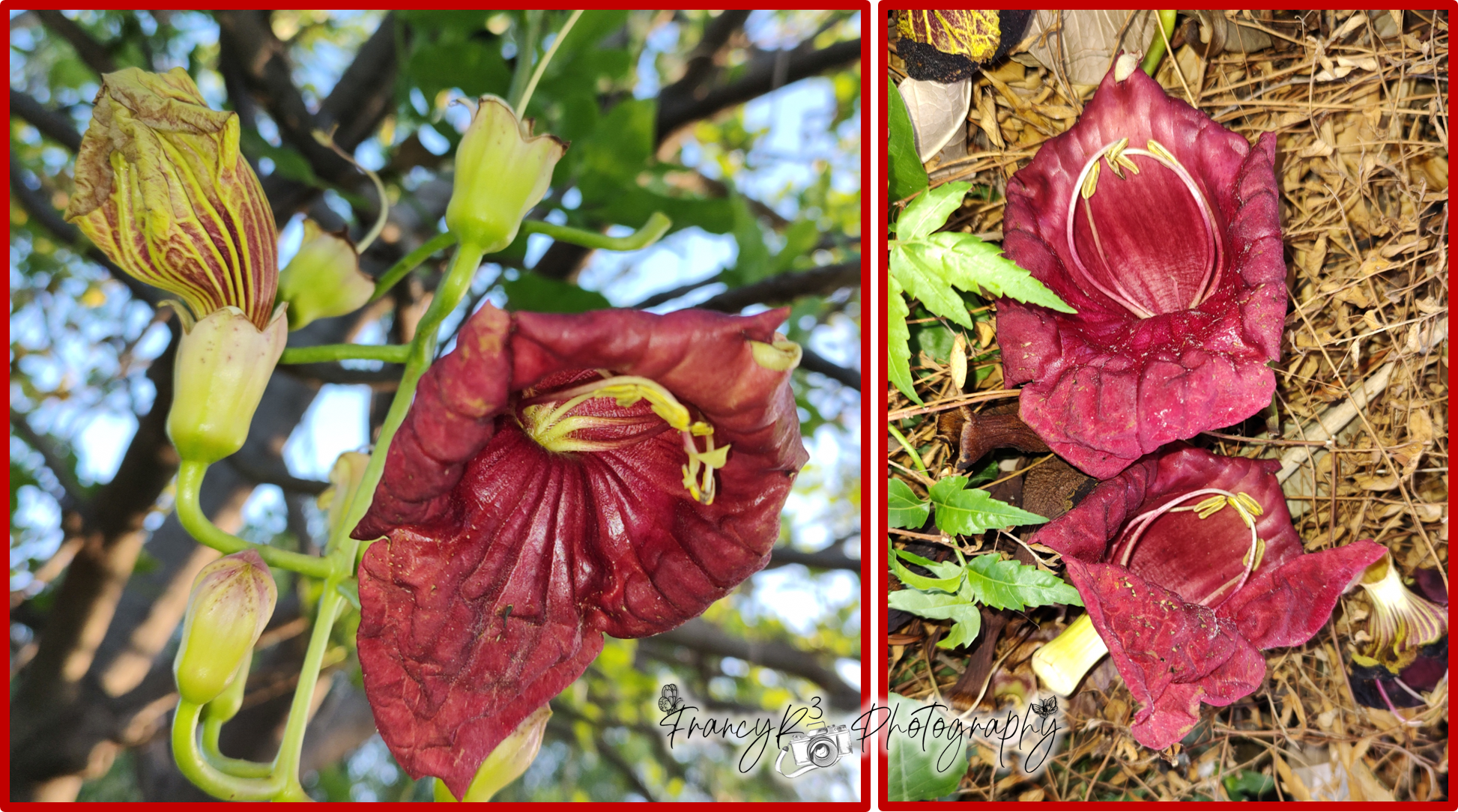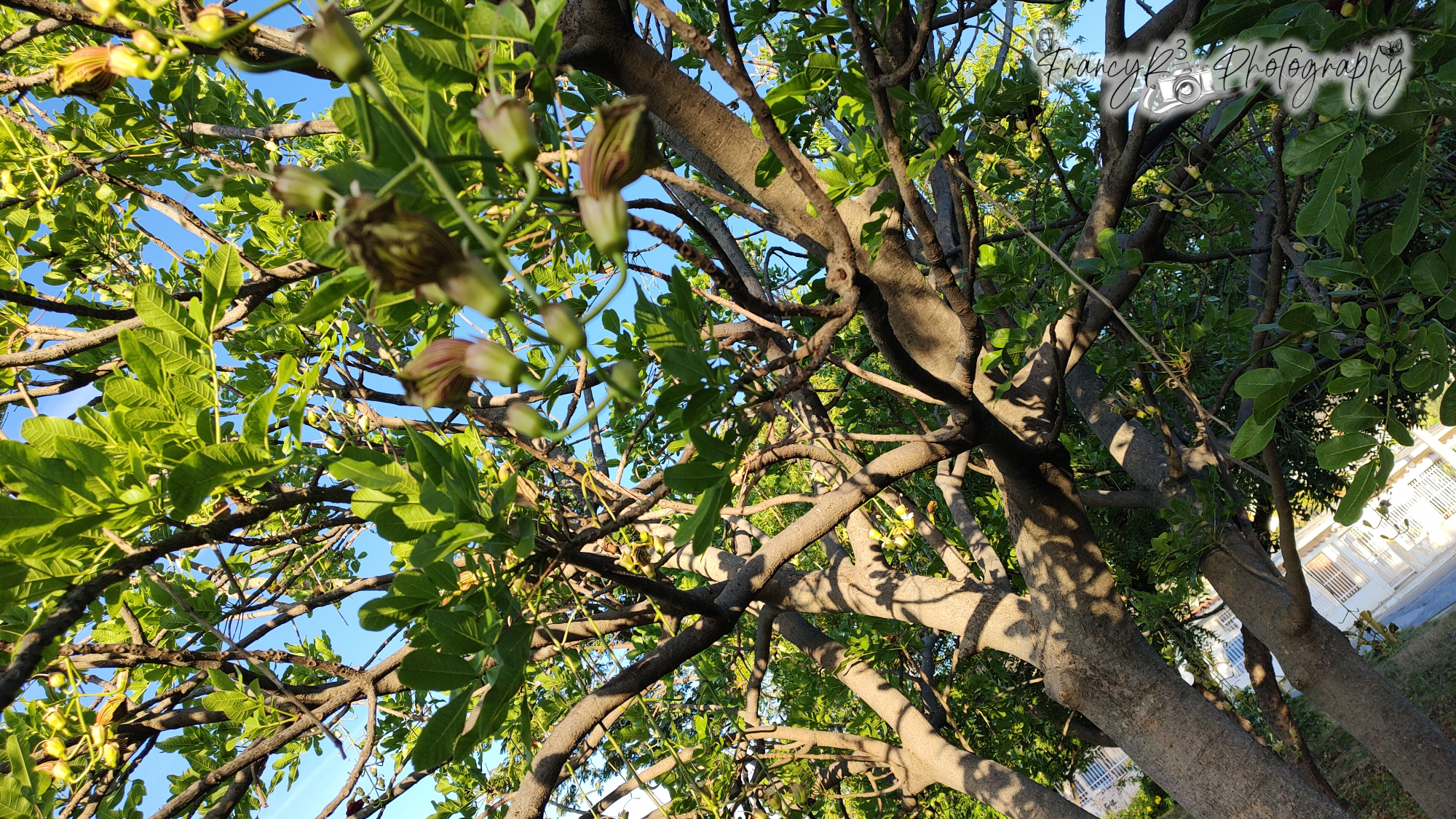Welcome Dear Photography Lovers
Bienvenidos Queridos Amantes de la Fotografía
Greetings to all, it is good to be back with you, and this time even more so, because I am here to tell you about a very curious tree. Since I discovered it in the little square in front of my house, some time ago, it had become a great unknown for me. I asked several neighbors and none of them could tell me the name of this tree with such strange flowers.


Hace una semana atrás decidí que era el momento de develar el misterio y con cámara en mano salí dispuesta a tomarle fotografías, para poder investigar en internet, de que planta se trataba. Mi sorpresa fue inmensa, cuando me entré que había descubierto un Árbol de Salchichas, jajajaja. Pues, aunque parezca una locura, así se conoce de forma popular este árbol, ese nombre que se lo debe a sus curiosos frutos, que se asemejan a grandes salchichas.
A week ago I decided that it was time to unveil the mystery and with camera in hand I went out ready to take pictures, to investigate on the internet, what plant it was. My surprise was immense, when I found out that I had discovered a Sausage Tree, hahahaha. Well, although it may seem crazy, this is how this tree is popularly known, this name is due to its curious fruits, which resemble large sausages.



Este árbol es originario del continente africano donde se le conoce por el nombre de Africaners Worsboom. Pero, si hablamos en términos botánicos, el nombre correcto de esta especie perteneciente a la familia Bignoniáceas y al género Kigelia, es Kigelia africana.
This tree is native to the African continent where it is known by the name of Africaners Worsboom. But, if we speak in botanical terms, the correct name of this species belonging to the family Bignoniaceae and the genus Kigelia, is Kigelia africana.



A simple vista, este árbol, es uno más del montón, pero, sus flores y frutos son lo que realmente lo hacen destacar. Pero, antes de tocar estos temas, hablemos de las características generales de este árbol semiperennifolio. Lo primero a destacar, es su longevidad, la cual ronda los 60 años aproximadamente; en cuanto a su altura en promedio alcanza los 10 metros. Por otro lado, su follaje es abundante de forma redondeada y un diámetro aproximado de 14 metros. El tronco, por su parte posee una corteza grisácea, la cual, mientras el árbol es joven es lisa, pero en la medida que pasan los años se va transformando en escamosa.
At first glance, this tree is just one of the bunch, but its flowers and fruits are what really make it stand out. But, before touching on these topics, let's talk about the general characteristics of this semi-evergreen tree. The first thing to highlight is its longevity, which is around 60 years approximately; as for its height, it reaches an average of 10 meters. On the other hand, its foliage is abundant with a rounded shape and an approximate diameter of 14 meters. The trunk, on the other hand, has a grayish bark, which, while the tree is young is smooth, but as the years go by it becomes scaly.



Como ya les comenté este árbol posee un abundante follaje, sus grandes hojas de forma ovalada y de un vistoso color verde llegan a medir unos 30 cm de largo. Se distribuyen en pares de forma opuesta y se ubican principalmente hacia los extremos de las ramas.
As I already mentioned, this tree has abundant foliage, its large oval-shaped leaves of a showy green color reach about 30 cm long. They are distributed in opposite pairs and are located mainly towards the ends of the branches.



Lo que realmente me llamo la atención de este árbol, fueron sus peculiares flores y muy especialmente su forma de crecen, la cual es muy curiosa. Resulta que se desarrollan en forma de una especie de racimos, y como pueden apreciar en las imágenes, de una especie de vara floral colgante, van emergiendo las flores a distintos niveles en grupos de 3 flores, me recuerdan una especie de candelabro. En promedio cada racimo tiene unas 12 flores hermafroditas, de un tamaño relativamente grande y de una forma acampanada. Sus 4 pétalos simple son de un llamativo color Vinotinto, en la parte frontal, sin embargo, en la parte posterior, son muy curiosas, porque son a rayas verdes y Vinotinto.
What really caught my attention of this tree, were its peculiar flowers and especially the way they grow, which is very curious. It turns out that they develop in the form of a kind of clusters, and as you can see in the pictures, from a kind of hanging floral rod, the flowers emerge at different levels in groups of 3 flowers, reminding me of a kind of candelabra. On average each cluster has about 12 hermaphrodite flowers, relatively large in size and bell-shaped. Their 4 single petals are of a striking red wine color on the front, however, on the back, they are very curious, because they are striped green and red wine.



Un dato interesante sobre las flores de este árbol, es que abren en las noches, y aunque una vez abiertas se mantienen así durante el día, su coloración tiende a evitar que sean polinizadas por los insectos, ya que, no son capaces de percibir la longitud de onda que irradia su color. En cambio, son polinizadas por murciélagos, quienes, no solo la identifican por el desagradable olor que despiden en la noche al abrir, sino que, además, al estar colgando la tienden a confundir con uno de ellos.
An interesting fact about the flowers of this tree is that they open at night, and although once open they remain open during the day, their coloring tends to prevent them from being pollinated by insects, since they are not able to perceive the wavelength that radiates its color. Instead, they are pollinated by bats, who not only identify them by the unpleasant smell they give off at night when they open, but also, when they are hanging, they tend to confuse them with one of them.


Source of the images of the fruit ||Fuente de las imágenes del fruto

Los frutos de esta planta también son muy peculiares, de hecho, le dan origen al nombre popular con el que se le conoce, que es Árbol de las Salchichas. Y esto se debe simplemente, a su similitud con este tipo de embutido, en cuanto a su forma, ya que, es cilíndrico. Este fruto de color marrón grisáceo, llega a medir de largo, como máximo 90 cm, por unos 15 cm de diámetro. Es sumamente duro y leñoso y al parecer debido a esto la propagación de sus semillas al menos en África, depende de los elefantes, ya que, al comerlos son los encargados de dispersar sus semillas. Yo he podido apreciar sus frutos, porque al árbol que se encuentra cerca de mi casa, nunca le he visto ninguno, las flores caen y los racimos se secan sin desarrollar el fruto. Imagino que le hace falta quien los polinicé, sin embargo, encontré imágenes en internet y se las coloco para que puedan apreciarlos.
The fruits of this plant are also very peculiar, in fact, give rise to the popular name by which it is known, which is Tree of sausages. And this is simply due to its similarity to this type of sausage, in terms of its shape, since it is cylindrical. This grayish-brown fruit measures a maximum of 90 cm in length and about 15 cm in diameter. It is extremely hard and woody and apparently because of this the propagation of its seeds, at least in Africa, depends on elephants, since they are in charge of dispersing the seeds when they eat them. I have been able to appreciate its fruits, because the tree that is near my house, I have never seen any, the flowers fall and the clusters dry up without developing the fruit. I imagine that it needs someone to pollinate them, however, I found images on the internet and I put them here so that you can appreciate them.



Finalmente, en cuanto al uso, además, del fruto de servir de alimento a los elefantes en África, en otros lugares donde se encuentra, suele ser ornamental. Aunque, al parecer en algunos sitios se consume el fruto con fines medicinales, y el pueblo Masái suelen fermentar la pulpa para preparar cerveza, pero, deben ser muy cuidadosos, porque si el fruto esta verde, es toxico. Algo que es importante destacar, es que, dentro de algunas culturas africanas, este árbol tiene un importante valor simbólico y religioso, debido, a que sus frutos son asociados con la fertilidad. Además, la pulpa del fruto tiene propiedades tonificantes, por lo que, las mujeres jóvenes la usan para frotar en sus cuerpos, para favorecer la tonicidad. Por último, la corteza, también es utilizada, para aplicar en las mordeduras de serpiente y para calmar dolores de muela y estómago.
Finally, as for the use of the fruit as food for elephants in Africa, in other places where it is found, it is usually ornamental. Although, apparently in some places the fruit is consumed for medicinal purposes, and the Masai people usually ferment the pulp to prepare beer, but they must be very careful, because if the fruit is green, it is toxic. Something that is important to note is that in some African cultures, this tree has an important symbolic and religious value, because its fruits are associated with fertility. In addition, the pulp of the fruit has toning properties, so young women use it to rub on their bodies to promote tonicity. Finally, the bark is also used to treat snake bites and to soothe toothaches and stomach pains.



Bueno, queridos lectores y amantes de la naturaleza, solo me queda despedirme, esperando que las imágenes e información que les comparto sobre este curioso árbol haya sido de su agrado. Muy especialmente, espero les guste a @bucipuci, @adalger y todo el equipo de trabajo de @dna y @amazingnature, ya que, es mi entrada para el concurso de esta semana, en el cual, si quieren participar, pueden acceder dando clip, al siguiente link Amazing Nature Contest: FREE TOPIC - #2/2/23. Mis mejores deseos bienestar y salud para todos, Dios los bendiga. Hasta la Próxima.
Well, dear readers and nature lovers, it only remains for me to say goodbye, hoping that the images and information I share with you about this curious tree have been to your liking. I especially hope that @bucipuci, @adalger and the whole team of @dna and @amazingnature like it, since it is my entry for this week's contest, in which, if you want to participate, you can access by clicking on the following link Amazing Nature Contest: FREE TOPIC - #2/2/23. Best wishes for your health and well being, God bless you all. See you next time.

Bibliographic References || Referencias Bibliográficas
https://es.wikipedia.org/wiki/Kigelia_africana
https://www.elsevier.es/es-revista-offarm-4-articulo-extracto-kigelia-propiedades-tensoras-antienvejecimiento-13094142
https://www.arbolesornamentales.es/Kigeliaafricana.htm
https://catalogofloravalleaburra.eia.edu.co/species/10
https://www.wikiwand.com/es/Kigelia_africana
https://colombia.inaturalist.org/taxa/81491-Kigelia-africana
https://www.riomoros.com/2013/02/el-arbol-de-las-salchichas-kigelia.html

Contenido y fotografías de mi propiedad intelectual
Información Técnica
| Cámara | Pentax * istDL |
|---|---|
| Lente | * Pentax 18-55 |
| Iluminación | Luz Natural |
| Locación | Barcelona, Estado Anzoátegui, Venezuela |
Content and photographs of my intellectual property
Technical information
| Camera | Pentax * istDL |
|---|---|
| Lens | * Pentax 18-55 |
| Lighting | Natural Light |
| Location | Barcelona, Anzoátegui State, Venezuela |



I appreciate your work and your post has been manually curated by Botanic team @oscurity on behalf of Amazing Nature Community. Keep up the good work!
Agradecida de recibir tu apoyo @oscurity, salud y bendiciones para ti y todo el equipo de trabajo de #Botanic y #AmazingNature
The rewards earned on this comment will go directly to the people( @francyrios75 ) sharing the post on Twitter as long as they are registered with @poshtoken. Sign up at https://hiveposh.com.
Gracias por el apoyo 😃
Siempre agradecida de recibir tu apoyo @ewkaw, bendiciones para ti y todo el equipo de trabajo de @qurator
Your content has been voted as a part of Encouragement program. Keep up the good work!
Use Ecency daily to boost your growth on platform!
Support Ecency
Vote for new Proposal
Delegate HP and earn more
Muchísimas gracias por su visita y apoyo 😃
thanks for sharing
We appreciate your work and your post was manually curated by @none! from the DNA team!
Reach us on Discord to learn more about the project!
Gracias @none por el apoyo, te envío miles de bendiciones a ti y todo el equipo de trabajo de @dna.org
Gracias por hablarnos sobre tu experiencia con este árbol y dárnoslo a conocer, es muy llamativo con sus frutos
Gracias a ti por la visita, salud y bendiciones para ti y los tuyos.